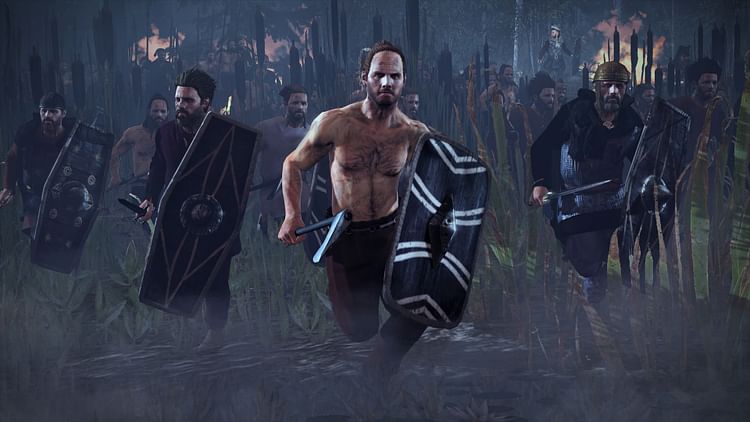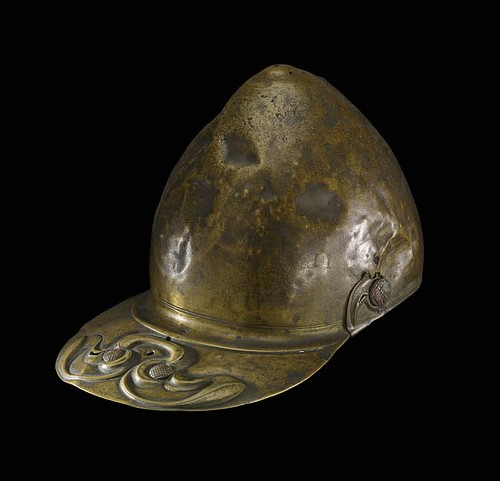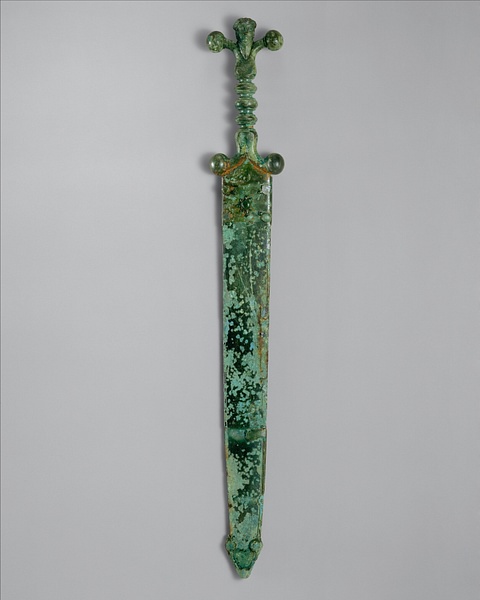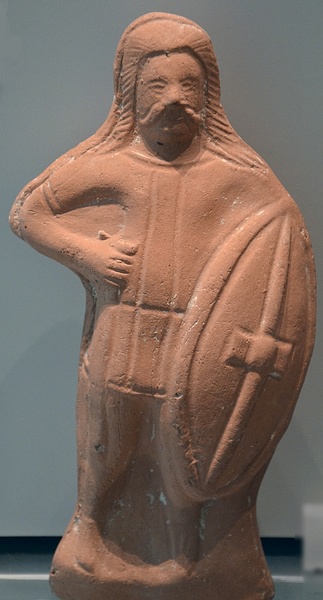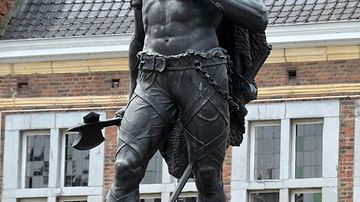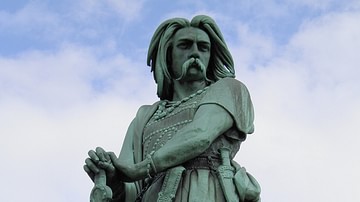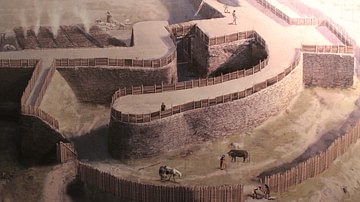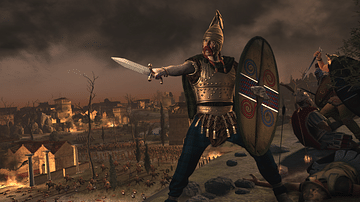
The warriors of Celtic Europe were amongst the most distinctive of any fighters in the ancient world. With their great height, long hair and moustaches, frequent nakedness, painted and tattooed bodies, and fondness for collecting enemy heads in battle, Celtic warriors were a fearsome sight to behold. Fighting on foot, horseback, or in a chariot, Celtic warriors are also notable for the inclusion of women in their ranks and sometimes as their leaders. Long-overshadowed by their ultimate victors the Romans and others, Celtic warriors such as Brennus (c. 390 CE), Vercingetorix (82-46 BCE), Ambiorix (c. 54/53 BCE), and Queen Boudicca (d. 61 CE) certainly caused their enemies trouble and impressed them with their determination and valour in battle.
The 'Barbarians' of Antiquity
Our best view of the Celts in terms of written sources is the works of Greek and Roman writers. Classical authors frequently identified those peoples living beyond their geographical control and knowledge as 'barbarians'. The Celts were called by the Greeks Keltoi or Galatae and by the Romans as Celtae or Galli. They were the peoples who spoke the Celtic language and inhabited Western and Central Europe from Iberia to the Danube through the 1st millennium BCE and several centuries into the 1st millennium CE. The Celts themselves likely had no feeling of belonging to a European-wide race but rather held allegiance to their local tribe or, at most, the confederation their tribe might belong to for the purposes of war. Consequently, any generalised treatment of the Celts must cover a vast geographical area and time period, and the reader is reminded that variations existed in all aspects of Celtic culture including warfare.
Another problem with any study of the Celts is the lack of written sources produced by themselves. These largely illiterate tribes stored and passed on their culture orally, especially through learned druids. Consequently, besides scarce short inscriptions and the physical finds of archaeology, we must rely on Greco-Roman writers for much of the details of Celtic warfare and life in general. Naturally, the Romans were the ultimate victors and so sources like Julius Caesar's Gallic Wars may be invaluable but they were not designed to record Celtic culture for posterity. Nor were these classical writers free from bias, misunderstanding and perpetuating stereotypes. When the 1st-century BCE writer Strabo noted of the Celts that "the whole race…is madly fond of war, high-spirited and quick to battle" (in Cunliffe, 213), was he accurately depicting an enemy or making the warriors of his own culture seem even more successful for conquering such a valiant foe? Nevertheless, classical authors are invaluable, and the Celts were well-known to them not only as an enemy but also later as mercenaries in Punic, Greek and Roman armies.

Ideology
It seems from what we know of Celtic religion that these peoples were indeed, as the Romans described them, somewhat preoccupied with war. Although the significance of early Celtic gods remains obscure, many of the great gods and goddesses, as seen in, for example, Irish-Celtic literature of the Middle Ages (which collated earlier oral traditions), were envisaged as warrior-heroes. Examples are Lugh and the Dagda. This is hardly unique and is seen in the pantheons of many other ancient cultures. The value given to martial affairs is further seen in Celtic grave goods which include weapons, armour, and chariots.
War was undertaken to acquire wealth, prestige, power, land, and vengeance. There were also specific raids aimed at capturing cattle and slaves, which could then be traded for luxury goods like portable gold objects and wine. Prestige was an important part of Celtic society, and esteem won in battle permitted a warrior to be given a better place at feasts and a choicer cut of the meat on offer. Further, leaders were expected to be generous to their followers, a situation that perpetuated raids and conflict to acquire ever-more wealth for distribution.
Celtic warriors were known for their extraordinary bravery in battle, and this may be explained in several ways. First and foremost, the honour system of Celtic culture meant that courage was a prime virtue. In addition, in the Celtic religion, there was a belief in an afterlife in the Otherworld which was considered like this life but without all the negative elements like disease, pain, and sorrow. In this sense, there was little to fear from death. Finally, there was a strong belief in totems (see below) which called on animal spirits and deities to protect the warrior in battle.
Finally, there were perhaps women warriors in some Celtic armies, although ancient writers give them little notice. Certainly, the Celtic gods included women such as the Irish-Celtic trio of war goddesses known as the Mórrigna: Badb, Macha, and the Mórrigan. In addition, in Celtic mythology, several male heroes, notably Cú Chulainn, learnt to use weapons from female masters such as Scáthach and Aife. There were fighting queens such as Boudicca, queen of the Iceni tribe in Britain, but whether women were trained separately from men and just how many fought in battle and how often is not known.
Appearance
Some Celtic warriors entered battle naked - a group which Roman writers called gaestae - and exactly why this is has perplexed scholars. It may be they wished to demonstrate their supreme confidence in their prowess and the protection offered them by their gods. Naked warriors may have seen this as a way to frighten the enemy, a method to better show off their status within the tribe via the jewellery they wore, or it was part of a group identity. Nudity may even have had practical reasons such as being able to fight without restrictions or a way to ensure wounds were not infected by dirty cloth, one of the most common problems in dealing with the wounded on the ancient battlefield.
Not all Celtic warriors were nudists, though. Many wore rough tunics, breeches, and cloaks, often with a distinctive checkerboard pattern that was a precursor to the later tartan seen in Scotland and Ireland. Those warriors of higher status would have worn jewellery of gold, bronze, or iron around their necks and wrists. Many Celtic warriors wore a torc necklace - the famous Dying Gaul statue of the Capitoline Museums in Rome wears one - and these were likely a symbol of status and rank within the community. Torcs likely also had a spiritual symbolism, but they were happily collected as war trophies by the Celts' enemies.
Other important symbols, often worn as a crest on helmets or as designs on armour and shields included a sun-disk or wheel, stag, horse, dog, raven, bull, and boar. It was perhaps believed that by wearing such a representation, the warrior would display the same positive qualities in battle. Celtic warriors in Gaul are described as bleaching their long hair using lime-water. In Britain, they wore tattoos and designs (especially spirals) painted on their bodies using woad, a blue dye. As with the animal designs, these were likely seen as offering the wearer some sort of spiritual protection.
Armour & Shields
Celtic shields were most often large, oval or rectangular, and made of wood and leather with buckles in metal and a central boss for added strength. The famous bronze Battersea Shield which was recovered from the River Thames and others like it were too fragile to be of any practical use in battle and were, therefore, only for ceremonial use. Only the higher status warriors wore armour, which could be in metal, leather, or stiffened organic material. Armour typically consisted only of breastplates or a chainmail vest.
Helmets were made of bronze, iron, or leather and sometimes had horns, feathers, or animal heads attached. Surviving examples are often conical, sometimes with cheekpieces or a peak like a modern baseball cap. One extravagant survivor from the 3rd century BCE is a helmet from Ciumesti in Romania which has a bird perched on the crown with moveable wings that would have flapped as the warrior charged into battle.
Weapons
Celtic cultures were adept at forging metals and so they produced strong and effective weapons. Youths began to train as warriors from age 14, attaching themselves to more experienced campaigners to learn the arts of war and become proficient using these weapons, which were often heavy.
The chief weapon for higher status warriors was the iron sword with a straight blade up to 90 centimetres long (35 inches). Celtic warriors used their swords to both slash and stab. The sword was carried in a metal, wood, or leather scabbard hung from a belt or, in the case of northern Britain, across the back. The sword handle and scabbard were frequently decorated using such materials as gold, silver, ivory, semi-precious stones, enamel, and pieces of coloured glass. The sword blade, too, might also carry stamped decoration such as animal motifs.
Secondary weapons were spears and lances with iron points which could be straight or twisted with a straight, notched, or serrated cutting edge. The more sophisticated spearheads were designed to cause maximum damage not just on penetration but also when withdrawn from flesh. Bows and arrows were used, as were leather slings to fire small stone or clay missiles but both of these weapons were likely only used in defensive positions like protecting a fort and not in set-piece battles. A weapon of last resort was a dagger with a long, wide blade kept in a scabbard. Surviving examples of daggers often having a torc-like appendage at the tip of the scabbard.
Tactics
Before a battle even began, the Celts were fond of proclaiming their family lineage and hurling insults at their opponents. A warrior then might offer the opportunity of one-on-one combat. This was, like their appearance, designed to intimidate the enemy. Certainly, compared to the more disciplined and regimented troops of Greek and Roman armies, the Celtic hordes shouting, jumping, and beating their shields must have been an unsettling experience. The Celts were not one raging disorganised mob, though. Warriors were grouped by tribe, with each contingent bearing a standard such as an animal totem. It is very likely there was a strict hierarchy of tribes based on honour. We also know that they did not all charge froward en masse but kept some troops back as a reserve to later reinforce weaker areas of the battle lines.
While most warriors fought on foot, some had horses and there were, up to the 1st century BCE, two-wheeled chariots which carried a warrior and the driver. Chariots were made from wood with leather or wicker flooring and sides to make them lighter and faster. They were attached to a pair of horses via a single pole. In addition, a wealthy warrior was accompanied by a number of attendants and retainers, the size of this entourage being a matter of prestige. These attendants would be near at hand in battle in order to replace their master's tired or wounded horse, for example. Both chariots and horses were likely reserved for ambushes and skirmishes or to pursue an enemy fleeing the field of battle. When used in battle, they were first used as a means to launch missiles at the enemy before the warrior dismounted and fought on foot. Chariots were replaced by cavalry and were no longer in use in continental Europe by the 3rd century BCE, but they did continue in Britain for a couple of more centuries.
The army in a pitched battle was given direction by its commanders who led from the front. Leaders often committed ritual suicide in the case of failure. Troops were organised and buoyed through the use of war horns. Known as the carnyx, the design of this instrument - seen in surviving examples and Celtic art - has an animal head form at the bell end. These long trumpets sometimes have a clapper in the mouth which would have increased the unworldly sound of the instrument.
When battle commenced, first lances were thrown, then the enemy engaged with handheld short spears and swords. When Celts fought Celts the battle quickly descended into individual contests. A common occurrence was to take the head of a defeated warrior as these were believed to contain the soul. The heads of particularly esteemed enemies were embalmed in cedar oil and kept for display.
When the Celts faced more organised armies like the Greeks and Romans, their limitations in strategy were exposed. The Greek phalanx - a close-knit line of soldiers protecting each other with their shields and bristling with lances - or the Roman legion formations where shields were used to create an impenetrable wall of moving men, did not usually break down and so the individual nature of Celtic warfare came a cropper against the organised teamwork of the enemy. The Celts did win several famous battles in antiquity, usually when their first frenzied charge broke down the enemy's formations or if they used terrain well to ambush armies, but in the long term, the Celts were vanquished not by superior bravery or even weaponry but by superior tactics and discipline.
